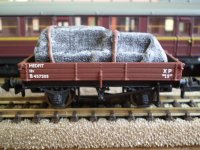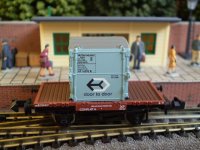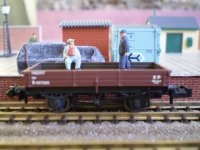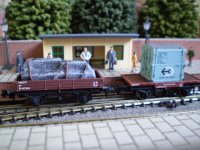One each of these authentic BR goods wagons from the Graham Farish standard range. In the
good old days before motorways and articulated lorries and traffic jams and road rage, railways
were the main, if not the only, practicable means of transporting goods from A to B. They had the
legal status of 'common carrier', which obliged them to collect pretty much anything from
anywhere and deliver it to wherever the customer wanted. Minerals travelled in open wagons,
parcels and boxes would be stacked up in vans. but larger items like crates of machinery would
be hoisted onto a low-sided wagon and covered up with a heavy-duty tarpaulin. The railwaymen
called this 'sheeting', and it protected the load against theft as well as against the weather. And
then off the wagon went in a lumbering goods train, stopping here there and everywhere to pick
things up and drop things off, until finally it got to the goods shed nearest to where the load was
going. Then the sheets would come off and the load would be craned off the wagon onto a van
or a cart for final delivery. This was the way rail transport worked, and for a century or more it
beat the competition hollow. But in the post-war era of BR, rail's long domination of goods
transport was drawing to a close, challenged by ever-bigger lorries on ever-faster roads, and to
meet the challenge BR had to come up with a quicker and easier way of doing things for this
new age. The traditional way of handling goods was too slow and labour-intensive, so that had
to change, and the solution was containerisation. No more lugging stuff from road to rail vehicles
and back again, instead the customer packed his goods on-site in a container. Then the container
was put on a lorry to go to the goods depot, where it was lifted straight onto a flat wagon for its
rail journey. At the other end it went back on a lorry to be delivered. All the time-consuming
handling, with its delay and expense, was eliminated at a stroke. BR thought this was the future
of goods transport, and they were right. The traditional wagonloads became a thing of the past,
and the containers grew ever bigger, ending up with today's monster tin boxes. And who was
BR's biggest advocate of this brave new world? None other than Dr Beeching.
Our wagons are painted up in the bauxite livery which BR used to denote 'fitted' vehicles equipped
with vacuum brakes, and carry the 'XP' designation indicating they could run in fast goods trains
and also as so-called 'tail traffic' attached to the rear of passenger trains. Both have detachable
loads: the 3-plank wagon has a hand-painted resin casting depicting a traditional sheeted goods
consignment, while the conflat has an AF container in BR's light blue 'Door to Door' livery of
the early 1960s. For a few brief years these two wagons would have run alongside each other,
as times changed and the new modern systems came in to replace the old ways, until finally the
slick new boxes took over and the crates and sheets vanished forever. Recreate the changing
times on your layout with our BR Goods Set.
|




